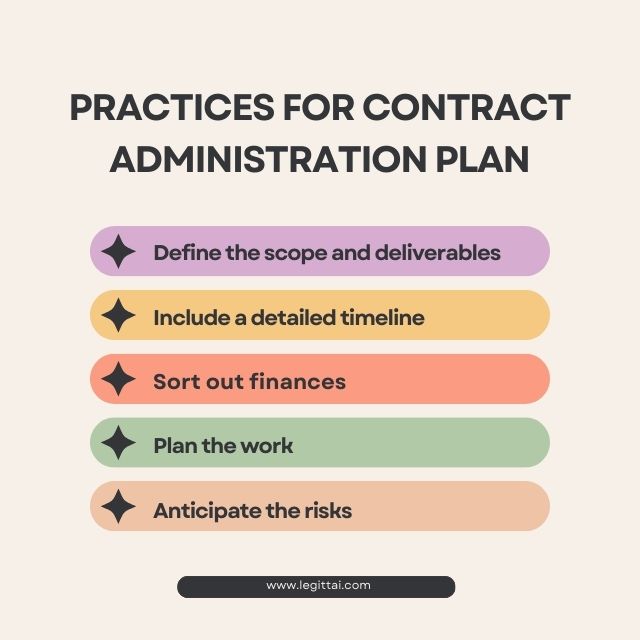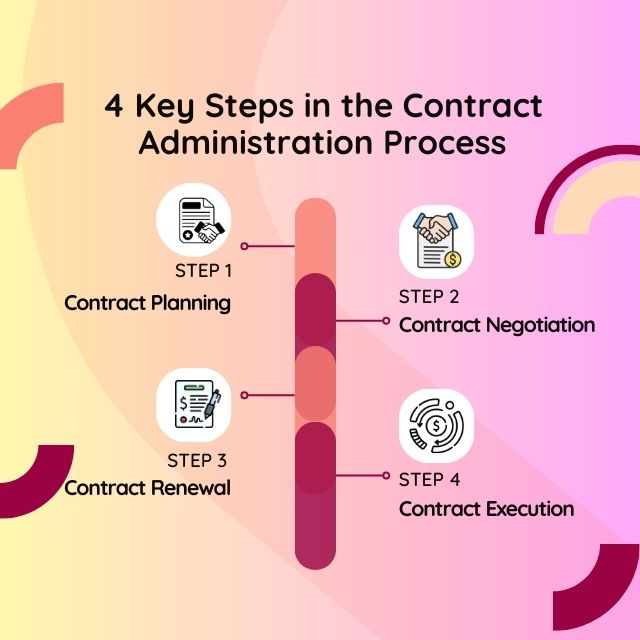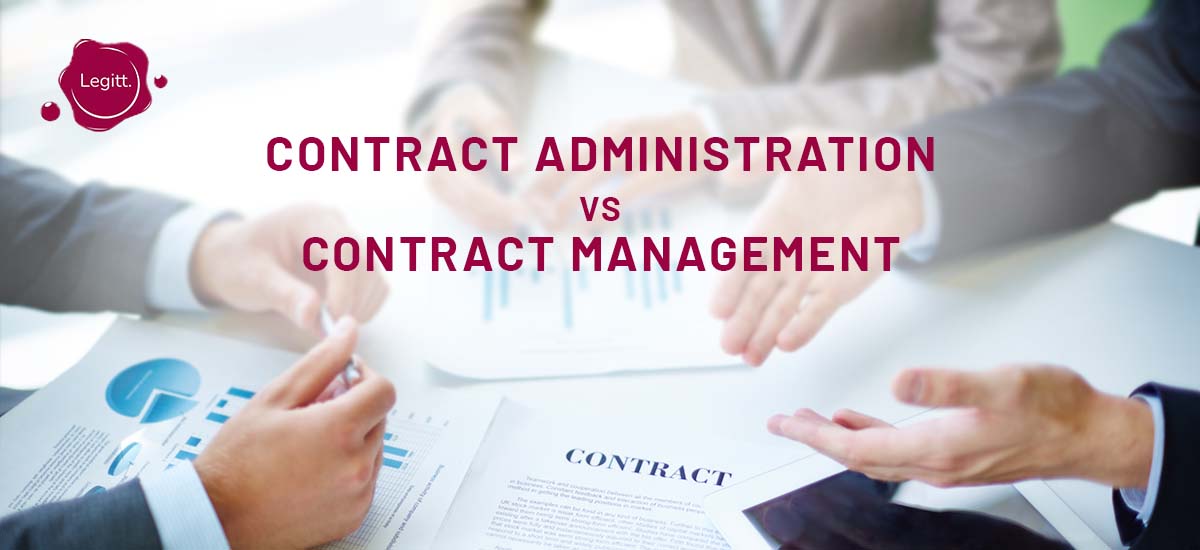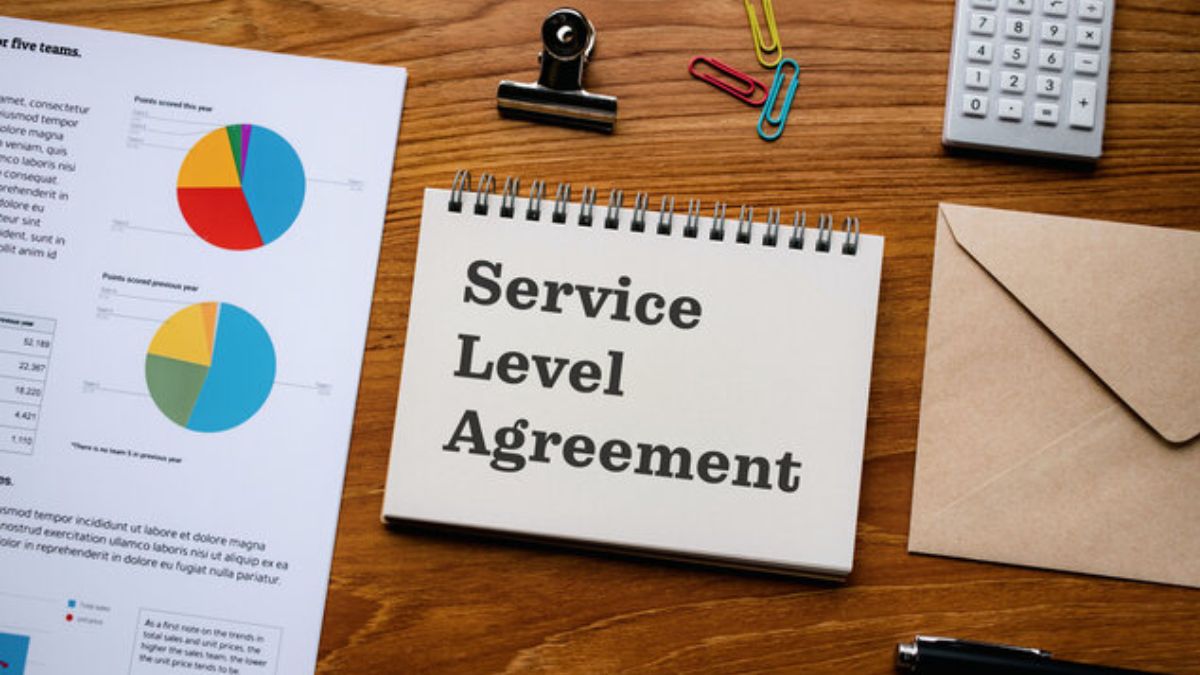What is Contract Administration Definition?
Contract administration is a vital process that occurs throughout the entire lifecycle of a contract. It involves managing the terms and conditions of a contract, ensuring that both parties fulfill their obligations, and resolving any issues that arise during the contract period. Contract administration is the work done before a contract is signed into effect, whereas contract management is the work done after the contract is signed to ensure that deliverables and deadlines are met as specified in the agreement. Contract administration professionals are in charge of the company’s contract administration and focus their efforts on contract planning and execution. The objective of contract administration is to ensure that all parties involved in an express or implied contract are fulfilling their duties and that the contract is being executed efficiently and effectively.
Also Read: Medallion signature guarantee vs notary
What’s inside?
What is The Difference Between Contract Administration and Contract Management
Contract administration vs contract management- These are two distinct phases in the lifecycle of a contract, although they are often used interchangeably but still, there is a lot of differentiation between these terms. To put it simply, contract administration is the work done before a contract is signed into effect, whereas contract management is the work done after the contract is signed to ensure that deliverables and deadlines are met as specified in the agreement. Below are the key difference between contract management and contract administration:
Also Read: Benefits of contract management software
Difference 1- Contract administration begins once contract management is completed
Contract management is the process of drafting, negotiating, and finalizing a contract. It involves identifying the requirements of both parties and working towards a mutually beneficial agreement. This process may involve identifying risks and negotiating terms and conditions that address those risks. Once the contract is finalized, the focus shifts to contract administration.
Difference 2- Contract administration is a continuous process
Contract administration, on the other hand, is the ongoing process of managing the contract after it has been executed. It involves ensuring that both parties fulfill their obligations, monitoring performance, and resolving any issues that arise during the contract period. This phase of the CLM tools requires careful attention to detail and effective communication to ensure that the contract is executed efficiently and effectively.
Also Read: How to write an addendum
Difference 3- Contract management is drafting-focused while contract administration is management focused
While blockchain contract management is focused on the initial negotiation and drafting of the contract, contract administration focuses on the ongoing management of the contract to ensure that it is being executed according to the agreed-upon terms. This may involve managing modifications and renewals, monitoring performance, and resolving disputes.
Difference 4- Contract administration requires regular performance monitoring
Effective contract management and administration are essential to the success of a project. Both phases require a team of skilled professionals who can effectively manage the contract and ensure that all parties are meeting their obligations. Clear communication, regular monitoring of performance, and effective issue resolution are key to successful contract administration.
Also Read: How to Write Contract Proposal
What is Contract Management?
Contract management takes place after a contract has been completed and entered into force. As a result, this requires working to guarantee that the key elements of contract management terms and conditions are followed and that all of a party’s contractual duties are met successfully.
It is entirely feasible that conditions will change throughout the contract management period, forcing changes to the contract agreement. Of course, the contract management team typically works closely with the other party to the agreement, so they are in a strong position to determine whether the connection is functioning or if alternative options should be pursued. As a result, assuming they are independent teams within the same company.
Also Read: Can I notarize for a family member in NY
Best Practices for Contract Administration Plan
Creating and adhering to a solid contract administration plan positions your team to successfully manage each new contract throughout the agreement’s lifecycle. This legal document should state in precise detail what is expected of both parties during the length of the agreement in order to limit potential types of breach of contract or other issues that lead to either party failing to meet their contractual duties.

When creating a contract administration plan, keep the five recommended practices in mind.
1. Define the scope and deliverables
The first step in achieving a successful contract creation process is to precisely define the scope and deliverables. Scope creep is a typical issue that may derail any contract, therefore specifying what the contract does and does not cover in writing will help keep the contract on course.
2. Include a detailed timeline
Contract administration plans should include a precise timeline that accounts for every major milestone throughout the contract’s life cycle, including project start and finish dates, deadlines for deliverables, and status updates.
3. Sort out finances
To avoid contract disputes and maintain positive relationships between both parties, everyone involved in the contract administration process should understand the financial terms of the agreement, including the contract’s value, payment intervals, and the process for dealing with any additional expenses (depending on the type of contract).
4. Plan the work
To promote transparency and accountability, the plan should include information on how the contract deliverables will be carried out, as well as the persons who will be working on each aspect of the agreement (including both internal and third-party staff, if relevant). Having a plan for monitoring success throughout the contract’s life cycle will keep both parties on track and allow for course correction if necessary.
5. Anticipate the risks
Every contract carries risk, but planning for those risks can help avoid the contract from failing. Outline the most likely hazards for each agreement, as well as the steps that should be followed if those events occur. Allowing for some wiggle room in schedules and budgets will allow minor, unanticipated delays or problems to be dealt with, preventing the contract (and potentially the relationship) from suffering considerably.
>>>Download and use free contract templates from Legitt
What is Contract Administration Process?
Contract administration is the process of planning, negotiation, execution and performance of any contact with customers or vendors. The process of drafting a contract between an employer and contractor is known as contract administration. Once the terms of the contract are decided upon and everyone has signed on the dotted line, the process is complete. In the event that something goes wrong or needs to be altered, these documents will safeguard both parties to the agreement.
The following are the key steps in the contract administration process or plan:

Step 1- Contract Planning
This involves monitoring the performance of both parties to ensure that they are meeting their contractual clauses and obligations. This may involve reviewing reports, conducting site visits, or communicating with project managers.
Step 2- Contract Negotiation
This involves making changes to the contract to reflect changes in the project scope, budget, or timeline. Contract modifications can be initiated by either party, and both parties must agree to any changes before they can be implemented.
Step 3- Contract Renewal
This involves renewing the contract once the original contract period has expired. The renewal process may involve renegotiating the terms of the contract or simply extending the existing contract.
Step 4- Contract Execution
This involves closing out the contract once all work has been completed and all obligations have been met. This may involve conducting a final inspection, submitting a final report, redlining contract or resolving any outstanding issues.
Also Read: How To Create An Electronic Signature
What Are The Roles of Contract Administrators?
Contract administrators work out how the contract should be drafted before the parties agree to the agreement. A contract administrator is incharge of contract planning, drafting, and closure. Contract administration duties are critical to the success of a project and it requires a team of skilled professionals who can manage the contract effectively. The following are some of the key roles and responsibilities of contract administrators and teams:
- Contract Administrator: The contract administrator is responsible for managing the day-to-day operations of the contract. This includes monitoring performance, managing modifications and renewals, and ensuring that all parties are meeting their obligations.
- Project Manager: The project manager is responsible for managing the project as a whole. This includes overseeing the work of all contractors and subcontractors, managing the budget and timeline, and ensuring that the project meets its objectives.
- Legal Counsel: Legal counsel provides advice and guidance on legal issues related to the contract. This includes reviewing the contract for compliance with legal requirements, advising on contract modifications and renewals, and resolving any legal disputes that arise.
- Financial Analyst: The financial analyst is responsible for managing the financial aspects of the contract. This includes monitoring the budget, preparing financial reports, and ensuring that all payments are made on time.
Also Read: How to Notarize a Document?
Conclusion
Contract administration is a complex process that requires careful attention to detail and a thorough understanding of the contract and its requirements. For creating, managing and automatically tracking contracts and agreements, you can use Legitt Contracts.
Did you find this article worthwhile? More engaging blogs about smart contracts on the blockchain, contract management software and electronic signatures can be found in the Legitt Blogs section. You may also contact Legitt to hire the best contract lifecycle management services and solutions.
FAQs on Contract Administration vs Contract Management
What is the role of contract administration?
The role of contract administration is to manage the day-to-day operations of a contract, ensure that both parties are meeting their obligations, and resolve any issues that arise during the contract period.
What are the key differences between contract management and contract administration?
Contract management involves the negotiation and finalization of a contract, while contract administration involves managing the ongoing operations of the contract to ensure that it is being executed according to the agreed-upon terms.
What are the best practices for contract administration and contract management?
Best practices for contract administration and management include establishing clear communication channels, monitoring performance, addressing issues promptly, and regularly reviewing and updating the contract to ensure it remains relevant.
How does contract administration and contract management vary across different industries?
Contract administration and management may vary across different industries based on factors such as regulatory requirements, contract complexity, and the level of risk involved. Industries with high-risk contracts, such as construction and healthcare, may require more extensive contract management and administration processes.
What are the requirements for contract administration?
The requirements for contract administration include having a comprehensive understanding of the contract, establishing clear communication channels, monitoring performance, and addressing issues promptly to ensure that both parties are meeting their obligations.
What are the different phases of contract administration?
The different phases of contract administration include contract execution, monitoring, modification and renewal, issue resolution, and contract closeout.
What are the legal implications of contract administration?
The legal implications of contract administration include ensuring compliance with applicable laws and regulations, mitigating risks, addressing breaches of contract, and ensuring that both parties fulfill their obligations as outlined in the contract.
How does contract administration differ between private and public sector organizations?
Contract administration may differ between private and public sector organizations due to differences in regulatory requirements, contract complexity, and the level of scrutiny involved. Public sector organizations may be subject to additional regulations and oversight compared to private sector organizations.
What is contract administration process?
The process of drafting a contract between an employer and contractor is known as contract administration. Once the terms of the contract are decided upon and everyone has signed on the dotted line, the process is complete. In the event that something goes wrong or needs to be altered, these documents will safeguard both parties to the agreement.
Define contract management and administration
Contract administration is the work done before a contract is signed into effect, whereas contract management is the work done after the contract is signed to ensure that deliverables and deadlines are met as specified in the agreement.






















